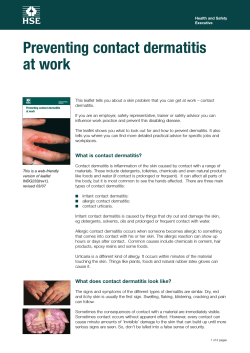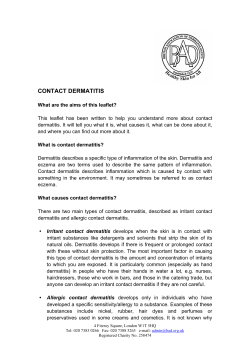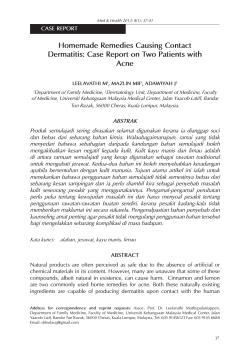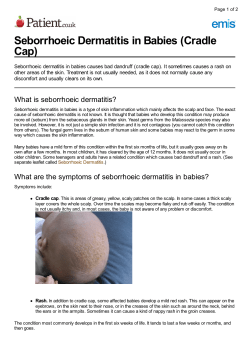
Skin Lecture 3
Pathology of the
Integumentary System
Lecture 3
Congenital / Environmental / Infectious
(web)
Paul Hanna
Apr 2015
CONGENITAL AND HEREDITARY SKIN DISEASE
Congenital Hypotrichosis
• all domestic species
• absence of hair follicles &/or abnormal follicular development
Cattle:
• hereditary vs acquired (BVD, iodine, pituitary hypoplasia, teratogens)
• r/o telogen or anagen defluxion
Dogs and Cats:
• several hereditary forms
Congenital hypotrichosis in an Ayrshire calf
(note: thin hair coat due to failure of normal
development of many of the hair follicles)
Anagen or Telogen Defluxion (Effluvium)
eg anagen defluxion following severe neonatal diarrhea / sepsis
CONGENITAL & HEREDITARY SKIN DISEASE
[For information only]
Hereditary collagen dysplasia (note: distensible
skin which tears easily)
Calf with ichthyosis - a congenital keratinization disorder
Mechanobullous disease / Epidermolysis Bullosa
[For information only]
www.beltina.org
Various forms of
epidermolysis bullosa
are recognized in
humans and domestic
animals that are
associated with inherited
defects of structural /
adhesion molecules in
the hemidesosomes &/or
basement membrane.
Mechanobullous disease / Epidermolysis Bullosa
Epidermolysis bullosa is described in Belgian
foals. In the first few days of life see skin / oral
ulceration and also separation / sloughing of
the hooves.
[For information only]
Mechanobullous disease / Epidermolysis Bullosa
Extensive subepidermal clefting causing vesicle / bulla
formation in the skin
[For information only]
CONGENITAL & HEREDITARY SKIN DISEASE
[For information only]
Pattern alopecia (Pattern baldness)
en.wikipedia.org/
Idiopathic bald thigh syndrome, a form of pattern
baldness seen in greyhounds
Also:
Color dilution alopecia
en.wikipedia.org/
Black hair follicular dysplasia
Other pattern baldness / follicular dysplasias
Canine Recurrent Flank Alopecia
aka = Seasonal (cyclic) flank alopecia
ENVIRONMENTAL INDUCED SKIN DISEASE
I. ACTINIC (SUN) INJURY
II. CHEMICAL INJURY
III. PHYSICAL INJURY
ACTINIC (SUN) INJURY
Epidemiology
• amount of light reaching skin:
Environmental Factors (atmosphere / latitude / altitude / shelter)
Host Factors (quantity of hair / pigmentation / stratum corneum / genetics)
Path of sunlight
through atmosphere
ACTINIC (SUN) INJURY
Etiopathogenesis
• visible light vs UV-A vs UV-B vs UV-C
• UV-B free radicals damages nucleic acids, proteins & lipids cell death
Note, arrows indicate apoptotic
keratinocytes (“sunburn cells”) due to UV-B
radiation. These can be induced within 30
minutes of sun exposure.
www.skin-science.com
ACTINIC (SUN) INJURY
Sunburn
• due to: direct endothelial damage
damage to keratinocytes with release of inflammatory mediators
Solar dermatitis
• chronically see thickened inflamed skin +/- dysplasia / neoplasia
Sunburn on udder of a goat
Fig 14-5 (Hnilica – Sm An
Derm) Feline Solar
Dermatosis. Alopecia,
erythema, erosions, and
crusting on the ear pinna.
As the disease
progresses, papules will
develop, with erosion and
ulceration that suggest
progression to squamous
cell carcinoma.
ACTINIC (SUN) INJURY
• Mutagenesis:
pyrimidine dimer formation; esp in mutation “hot spots” on P53 gene
impairs P53 protein function
also promoter preferential replacement of damaged cells with mutated P53 cells
UV induced pyrimidine dimer formation
UV induced permanent mutation
ACTINIC (SUN) INJURY
Note: pyrimidine dimers are usually corrected by the
Nucleotide Excision Repair (NER) mechanisms. Even if it
was 99.9% effective, the more mutations there are, the
increased risk of one remaining unrepaired. Also certain
individuals can have defects in their NER repair mechanism.
ACTINIC (SUN) INJURY
ADDITIONAL
SUNBURNS
UV light can also be a tumor promotor – note UV light can not only cause somatic mutations of the cells (left image), it
can also act as a cancer promoter, ie sunburns injures/kills keratinocytes which results in hyperplasia. Hyperplasia
is fertile ground for inducing additional mutations / neoplastic transformation.
ACTINIC (SUN) INJURY
Photosensitization
• photodynamic substances in skin are activated by UV-A or visible light
Type I exogenous origin of photodynamic agents
Type II aberrant heme pigment synthesis
Type III (hepatogenous type) failure to remove phylloerythrin
Type IV idiopathic
Photosensitization after treatment with a phenothiazine anthelmintic
Many plants contain chemicals which are
photoreactive, eg St John’s wort (above)
Photosensitization associated with liver disease; note
only poorly haired &/or white haired areas affected
Photosensitization in cattle; note only white areas affected.
There is enough pigment in the colored hair to absorb / block
the light and prevent activating the photodynamic agents.
CHEMICAL INJURY
Local application
• agent must penetrate hair & st. corneum; enhanced by moisture &/or damage
Systemic absorption
• ingestion of toxins with systemic effects on the skin and usually other organs
CHEMICAL INJURY
1. Primary Contact Irritant Dermatitis
• skin contact by substances expected to cause irritation:
caustic chemicals (eg acids, alkalis)
concentrated drugs (eg insecticides)
soaps / detergents
body excretions (eg anal sac, urine)
Contact irritant dermatitis
(eg concentrated pour-on insecticide)
Contact irritant dermatitis
(eg concentrated lye solution)
CHEMICAL INJURY
2. Gangrenous Ergotism and Fescue Toxicosis
3. Many Others: thallium, selenium, mercury, arsenic, etc
gangrenous necrosis of distal limbs due to ergotism
PHYSICAL INJURY
Abrasion / Laceration / Ulceration / Foreign Bodies
Radiation
Extremes in Temperature
Callus / Hygroma
Feline Psycogenic Dermatitis
Burn victim – note epidermal necrosis, ulcers / crusts
PHYSICAL INJURY
Acral Lick Dermatitis
• esp large active breeds, esp < 5 yrs
• psychogenic boredom &/or anxiety
Acral lick dermatitis, note focal area of
alopecia, erythema, erosion / ulceration
INFECTIOUS SKIN DISEASE
VIRAL SKIN DISEASES
BACTERIAL SKIN DISEASES
MYCOTIC SKIN DISEASES
PARASITIC SKIN DISEASES
PROTOZOAL SKIN DISEASES
VIRAL SKIN DISEASES
Local Infection
• intact skin resistant to local infecting viruses (eg papilloma / poxviruses)
• requires abrasion or arthropod bite
Contagious Pustular Dermatitis (= contagious ecthyma = "Orf“)
• common / worldwide parapoxvirus infection of sheep & goats.
• typical pox phases (vesicles / pustules / crusts) but more hyperplastic / proliferative
Fig. 17-31 (Zachary) Schematic diagram of the development of a poxvirus lesion over time.
Contagious Pustular Dermatitis
• mouth lips and oral cavity; ± eyelids, feet, mouth; rarely GI tract / viscera
Note, ballooning degeneration and
intracytoplasmic inclusion bodies.
Contagious pustular dermatitis is a
relatively common zoonosis in
individuals handling sheep & goats
Systemic Viral Infection
• epitheliotropic
• pantropic
• other, eg 2o to pruritus
Canine distemper – “hard pad”
Vesicular exanthema
Scrapie
VIRAL SKIN DISEASES
Diagnosis
•
•
•
•
history & clinical signs / lesions
skin biopsy
serology
virus isolation or identification
Raccoon – scale / crust on
distal limbs due to canine
distemper virus infectiona
VIRAL SKIN DISEASES
CANINE
Papilloma virus
Canine distemper virus
CATTLE
Bovine mammillitis virus
Pseudocowpox
Papilloma virus
SWINE
Swinepox
HORSES
Papilloma virus
Swinepox
BACTERIAL SKIN DISEASES (PYODERMAS)
healthy skin is resistant to bacterial infection due to:
lack of moisture
stratum corneum forms physical barrier & continuous desquamation
antibacterial effects of sebum / sweat and the normal microflora
factors assisting bacterial colonization / proliferation:
moisture and dirt
altered cornification
physical damage
• result depends on agent pathogenicity / host defence mechanisms
BACTERIAL SKIN DISEASES (PYODERMAS)
• pyodermas are common in dogs
PRIMARY
SECONDARY
Otherwise healthy
Not healthy
BACTERIA
One species
> 1 species
PATTERN
Characteristic
Not characteristic
Successful
Not successful
SKIN
ANTIBIOTICS
BACTERIAL SKIN DISEASES (PYODERMAS)
SUPERFICIAL
DEEP
epidermis
dermis / subcutis
no scarring
scarring
short
chronic
LYMPH NODE
no
yes
SYSTEMIC
no
+/-
pustules, crusts
pustule, nodule, abscess, sinus
pustular &/or perivascular
dermatitis with neutrophils
folliculitis / furunculosis
&/or nodular to diffuse
dermatitis / panniculitis,
suppurative to granulomatous,
± bacterial agent
INVOLVE
REPAIR
DURATION
GROSS
HISTOLOGY
BACTERIAL SKIN DISEASES (PYODERMAS)
Diagnosis
history & lesions
culture
skin biopsy
Fig 3-14 (Hnilica – Sm An Derm) Superficial
Pyoderma. Erythematous dermatitis with
epidermal collarettes formation is apparent.
CANINE
Pyotraumatic dermatitis ("hot spots” or “acute moist dermatitis”)
• intense pruritus self-trauma secondary bacterial infection.
note: focal alopecia, excoriation
(erosion / ulceration), exudation
CANINE
Impetigo
• primary superficial pustular dermatitis, esp dogs (“puppy pyoderma”)
• predisposed by moist / dirty environments, abrasions, parasitism, poor nutrition
Note, pustules and epidermal collarettes
CANINE
Skin fold pyoderma
FELINE
Subcutaneous Abscesses
Note, bite wounds overlying area of inflammation (panniculitis / cellulitis and abscessation), which is
not obvious on external visual examination, ie often need to dissect to find the underlying inflammation.
RUMINANTS
Papillomatous Digital Dermatitis (“hairy heel warts”)
Initially an erosive / ulcerative plaque-like lesion, which is intensely painful and progresses to a
proliferative / papillomatous (with long, thin papillae), less painful lesion
Papillomatous Digital Dermatitis
See epidermal hyperplasia & prominent papillae
extending from the surface. Basophilic material
at base of papillae is composed of myriads of
bacteria (H&E stain).
Note, see myriads of spirochete bacteria along
the epidermal surface with silver staining.
Papillomatous Digital Dermatitis
Transmission electron micrograph showing numerous spirochetes in an advanced stage of a
typical digital dermatitis lesion.
[Choi BK, et al. Spirochetes from digital dermatitis lesions in cattle are closely related to treponemes associated
with human periodontitis. Int J Syst Bacteriol. 1997 Jan;47(1):175-81]
RUMINANTS
Dermatophilosis (D. congolensis)
• a superficial exudative dermatitis, seen most commonly in hot, humid areas.
Characteristic branching filaments of D. congolensis; filaments undergo
longitudinal & transverse septation to form parallel rows of coccoid bodies.
PORCINE
Exudative Epidermitis (Greasy Pig Disease)
• acute, rapidly spreading, often fatal exudative pyoderma of suckling to weaner pigs.
• infection with Staphylococcus hyicus, which have exfoliative exotoxins.
In the common peracute
form see greasy brownblack exudate / crust
which typically starts on
face &/or limbs and
quickly spread to the
entire body.
Note: cell crusts
composed of degenerate
inflammatory cells
admixed with keratin,
bacteria
PORCINE
Septicemia
Salmonella
"Diamond Skin Disease"
Salmonellosis - or other endotoxemias; note venous
infarction of extremities due to endotoxin induced venous
thrombosis.
“Diamond Skin Disease” in pig with Swine Erysipelas
Note rhomboid / ‘diamond shaped’ erythematous
plaques typical of infection with Erysipelothrix rhusiopathiae.
MYCOTIC SKIN DISEASES
Cutaneous Mycoses
Dermatophytosis (Ringworm)
Malasseziasis
Candidiasis
Subcutaneous Mycoses
Systemic Mycoses
Diagnosis
history & lesions
fungal id / culture
skin biopsy
Dermatophytosis (Ringworm)
• common / worldwide distribution; mainly Microsporum & Trichophyton
• young / immunocompromised
• predisposing factors: overcrowding, high humidity, poor sanitation / nutrition
• contagious direct or fomites
• attacks keratinized layers inflammation due to proteases
Dermatophytosis (Ringworm)
• circular patches of scaling / alopecia to papules / pustules / furunculosis / crusting
Canine pinna, note focal alopecia,
erythema and scaling
Bovine head, note mulifocal alopecia with scaling / crusting
Dermatophytosis (Ringworm)
note multiple to coalescing areas of alopecia with scale &
crust
Dermatophytosis (Ringworm)
Ringworm is the most commonly reported zoonosis in people
working with cattle. Although less common in small animals, one
study indicated ~50% of people exposed to either symptomatically
or asymptomatically infected cats develop lesions.
Note: arthrospores surrounding and hyphae
within hair shaft.
Malasseziasis (Malassezia pachydermatis)
• yeast that are part of the normal microflora proliferate & cause dermatitis
secondary to underlying skin disease (eg allergies, seborrhea).
Malasseziasis in a couple of Westies (above) and same dogs
following treatment (right).
Nett CS, et al. Epidermal dysplasia and Malassezia infection in
two West Highland White Terrier siblings. Vet Dermatol. 2001
Oct;12(5):285-90.
Fig. 17-54B (Zachary) Stratum corneum contains numerous Malassezia pachydermatis yeast (arrows), which are bilobed
(“peanut”-shaped). The dermis is mildly edematous—note the mild separation of the collagen bundles by nonstaining to
lightly amphophilic extracellular fluid. Gomori's methenamine silver stain–H&E counter stain. [note: cytologic methods are
much more sensitive than histology in detecting yeast]
Subcutaneous Mycoses
• traumatic implantation of a wide variety of saprophytic fungi
Systemic Mycoses
primarily by inhalation; esp Blastomycosis & Cryptococcosis
host usually has compromised resistance to infection
Papular / nodular dermatitis,
due to Blastomycosis
note: crusted papules /
nodules on nostril and lip.
© Copyright 2025









